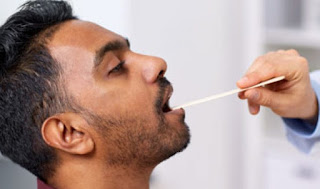Peripheral Giant Cell Granuloma Pictures, Symptoms, Causes, Treatment
Peripheral giant cell granuloma is a pathological condition which involves oral cavity. It appears as an overgrown tissue. The main reasons behind this abnormal growth may be irritation or trauma. Basically peripheral giant tissue granuloma involves gingival part of oral cavity, so it may be associated with other diseases as well. These diseases may be peripheral ossifying fibroma and pyogenic granuloma. This granuloma has microscopic appearance and it is considered to be involving soft tissues.
Due to involvement of soft tissues, it is sometimes considered as central giant cell granuloma. The color of this peripheral giant cell carcinoma ranges from red to bluish purple. As compare to pyogenic granuloma, peripheral giant cell granuloma is more blue in color. This granuloma may be sessile and is smaller in size. Its size is usually less than 2 cm. peripheral giant cell carcinoma mostly occur in people around 50 to 60 years of age.
It only involves the gingival part of mouth but rarely it does involves edentulous alveolar ridge. Mandible jaw is more commonly seen with peripheral giant cell granuloma as compare to maxilla jaw line. It may occur on both anterior and posterior areas or on either side.

The cause behind peripheral giant cell granuloma is still not known. There are two main causes reported behind it. the 1st main cause is local irritation. It may occur due to continuous irritation on the gums. This irritation may be due to calculus or formation of dental plaque. Irritation may occur due to periodontal diseases, bad or poor dental restorations and the inappropriate fitting of dental extractions. All these conditions may lead to the local irritation and this irritation leads to the formation of lesion and as a result, peripheral giant cell granuloma occurs.
The granuloma involves the gingival region of oral cavity. It usually occur on the mandible jaw instead of maxilla jaw line. The lesion is smaller in size usually less than 2cm. the color of peripheral giant cell granuloma is dusky purple. It is smooth surfaced and sessile. This granuloma looks like dome shaped papules or nodules. The granuloma may grow larger in size and exceed 5 cm of size. The granuloma involves alveolar mucosa. According to an estimation, there are 70 percent cases with peripheral giant cell granuloma in the anterior side. Commonly premolar, canine and incisor region is involved.
Peripheral giant cell granuloma involves the oral cavity which is a complicated area to treat surgically. Great care is needed. There is a surgical way to remove these peripheral giant cell granuloma lesions. There may be complications during surgery if there is any teeth adjacent to lesion. It is more difficult to treat granuloma lesion at the anterior side. Teeth are cleared side by side with scaling process and root planning. As these processes helps in reducing the irritation. The reoccurrence rate of peripheral giant cell granuloma is only 10 percent.
Due to involvement of soft tissues, it is sometimes considered as central giant cell granuloma. The color of this peripheral giant cell carcinoma ranges from red to bluish purple. As compare to pyogenic granuloma, peripheral giant cell granuloma is more blue in color. This granuloma may be sessile and is smaller in size. Its size is usually less than 2 cm. peripheral giant cell carcinoma mostly occur in people around 50 to 60 years of age.
It only involves the gingival part of mouth but rarely it does involves edentulous alveolar ridge. Mandible jaw is more commonly seen with peripheral giant cell granuloma as compare to maxilla jaw line. It may occur on both anterior and posterior areas or on either side.
Peripheral Giant Cell Granuloma Pictures

Peripheral Giant Cell Granuloma Causes
The cause behind peripheral giant cell granuloma is still not known. There are two main causes reported behind it. the 1st main cause is local irritation. It may occur due to continuous irritation on the gums. This irritation may be due to calculus or formation of dental plaque. Irritation may occur due to periodontal diseases, bad or poor dental restorations and the inappropriate fitting of dental extractions. All these conditions may lead to the local irritation and this irritation leads to the formation of lesion and as a result, peripheral giant cell granuloma occurs.
Peripheral Giant Cell Granuloma Symptoms
The granuloma involves the gingival region of oral cavity. It usually occur on the mandible jaw instead of maxilla jaw line. The lesion is smaller in size usually less than 2cm. the color of peripheral giant cell granuloma is dusky purple. It is smooth surfaced and sessile. This granuloma looks like dome shaped papules or nodules. The granuloma may grow larger in size and exceed 5 cm of size. The granuloma involves alveolar mucosa. According to an estimation, there are 70 percent cases with peripheral giant cell granuloma in the anterior side. Commonly premolar, canine and incisor region is involved.
Peripheral Giant Cell Granuloma Treatment
Peripheral giant cell granuloma involves the oral cavity which is a complicated area to treat surgically. Great care is needed. There is a surgical way to remove these peripheral giant cell granuloma lesions. There may be complications during surgery if there is any teeth adjacent to lesion. It is more difficult to treat granuloma lesion at the anterior side. Teeth are cleared side by side with scaling process and root planning. As these processes helps in reducing the irritation. The reoccurrence rate of peripheral giant cell granuloma is only 10 percent.
Peripheral Giant Cell Granuloma Pictures, Symptoms, Causes, Treatment
 Reviewed by Simon Albert
on
February 08, 2019
Rating:
Reviewed by Simon Albert
on
February 08, 2019
Rating:
 Reviewed by Simon Albert
on
February 08, 2019
Rating:
Reviewed by Simon Albert
on
February 08, 2019
Rating:











